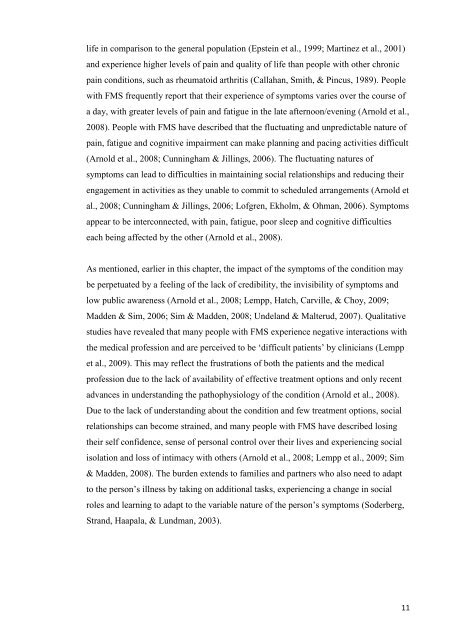Sick and Tired: Understanding and Managing Sleep Difficulties in ...
Sick and Tired: Understanding and Managing Sleep Difficulties in ...
Sick and Tired: Understanding and Managing Sleep Difficulties in ...
You also want an ePaper? Increase the reach of your titles
YUMPU automatically turns print PDFs into web optimized ePapers that Google loves.
life <strong>in</strong> comparison to the general population (Epste<strong>in</strong> et al., 1999; Mart<strong>in</strong>ez et al., 2001)<br />
<strong>and</strong> experience higher levels of pa<strong>in</strong> <strong>and</strong> quality of life than people with other chronic<br />
pa<strong>in</strong> conditions, such as rheumatoid arthritis (Callahan, Smith, & P<strong>in</strong>cus, 1989). People<br />
with FMS frequently report that their experience of symptoms varies over the course of<br />
a day, with greater levels of pa<strong>in</strong> <strong>and</strong> fatigue <strong>in</strong> the late afternoon/even<strong>in</strong>g (Arnold et al.,<br />
2008). People with FMS have described that the fluctuat<strong>in</strong>g <strong>and</strong> unpredictable nature of<br />
pa<strong>in</strong>, fatigue <strong>and</strong> cognitive impairment can make plann<strong>in</strong>g <strong>and</strong> pac<strong>in</strong>g activities difficult<br />
(Arnold et al., 2008; Cunn<strong>in</strong>gham & Jill<strong>in</strong>gs, 2006). The fluctuat<strong>in</strong>g natures of<br />
symptoms can lead to difficulties <strong>in</strong> ma<strong>in</strong>ta<strong>in</strong><strong>in</strong>g social relationships <strong>and</strong> reduc<strong>in</strong>g their<br />
engagement <strong>in</strong> activities as they unable to commit to scheduled arrangements (Arnold et<br />
al., 2008; Cunn<strong>in</strong>gham & Jill<strong>in</strong>gs, 2006; Lofgren, Ekholm, & Ohman, 2006). Symptoms<br />
appear to be <strong>in</strong>terconnected, with pa<strong>in</strong>, fatigue, poor sleep <strong>and</strong> cognitive difficulties<br />
each be<strong>in</strong>g affected by the other (Arnold et al., 2008).<br />
As mentioned, earlier <strong>in</strong> this chapter, the impact of the symptoms of the condition may<br />
be perpetuated by a feel<strong>in</strong>g of the lack of credibility, the <strong>in</strong>visibility of symptoms <strong>and</strong><br />
low public awareness (Arnold et al., 2008; Lempp, Hatch, Carville, & Choy, 2009;<br />
Madden & Sim, 2006; Sim & Madden, 2008; Undel<strong>and</strong> & Malterud, 2007). Qualitative<br />
studies have revealed that many people with FMS experience negative <strong>in</strong>teractions with<br />
the medical profession <strong>and</strong> are perceived to be „difficult patients‟ by cl<strong>in</strong>icians (Lempp<br />
et al., 2009). This may reflect the frustrations of both the patients <strong>and</strong> the medical<br />
profession due to the lack of availability of effective treatment options <strong>and</strong> only recent<br />
advances <strong>in</strong> underst<strong>and</strong><strong>in</strong>g the pathophysiology of the condition (Arnold et al., 2008).<br />
Due to the lack of underst<strong>and</strong><strong>in</strong>g about the condition <strong>and</strong> few treatment options, social<br />
relationships can become stra<strong>in</strong>ed, <strong>and</strong> many people with FMS have described los<strong>in</strong>g<br />
their self confidence, sense of personal control over their lives <strong>and</strong> experienc<strong>in</strong>g social<br />
isolation <strong>and</strong> loss of <strong>in</strong>timacy with others (Arnold et al., 2008; Lempp et al., 2009; Sim<br />
& Madden, 2008). The burden extends to families <strong>and</strong> partners who also need to adapt<br />
to the person‟s illness by tak<strong>in</strong>g on additional tasks, experienc<strong>in</strong>g a change <strong>in</strong> social<br />
roles <strong>and</strong> learn<strong>in</strong>g to adapt to the variable nature of the person‟s symptoms (Soderberg,<br />
Str<strong>and</strong>, Haapala, & Lundman, 2003).<br />
11

















